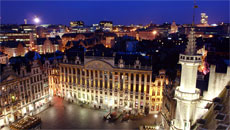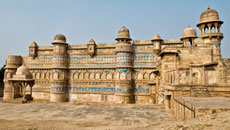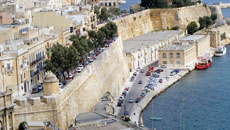From strolling down the left bank of the Seine, to tucking into a local café to ordering your steaming cup of café au lait, Paris never ceases to enchant you. Maybe it’s the interesting overlay of century old history with modern invention, or the way they say mademoiselle. Whatever it is (a certain je ne sais quoi, perhaps?) it proves to be powerfully enthralling. When you travel to Paris, it’s important to remember that there is no way you can cover everything in one go, especially if your trip is short. However, it is possible to visit several areas and still get the quintessential Parisian experience.
First things first, The Eiffel Tower. The 1000-foot tall lattice structure is one of the most distinguishable towers in the world, and for good reason. It’s definitely worth making a visit to the structure to see it up close. Better yet, wait until its dark and at the top of every hour, the tower will greet you with a frenzy of sparkling lights. Champagne bottles pop, cameras flash, and cries of general merriment exude from the passionate crowd. While you’re at it, be sure to stop and visit all the iconic monuments. Although it may be easy to question all the hype, most are definitely worth seeing. Specifically, Notre Dame and the Arc De Triomphe, which are both impressive in size and feature.
The Notre Dame cathedral was built 700 years ago and has an illustrious history. Renowned as one of the most famous examples of French Gothic architecture, it was the first building in France to use flying buttresses. From the menacing gargoyles to the rose stained glass, this magnificent church is a sight definitely worth the wait. The Arc De Triomphe is an important monument in France as it was built to honour the soldiers that fought in the Napoleonic and French Revolutionary wars. If you wait to ascend until 8 or 9 pm in the evening, the wait time is less than 20 minutes and the views are breathtaking. From the top you can see some of Paris’s most renowned sights, including the Eiffel Tower, Sacré Coeur, the Louvre and the Champs-Élysées. The Arc is situated at an intersection called the Etoile, which means star. It is named so because 12 main avenues meet at this point, creating an expanse of shimmering light in all directions – a truly beautiful sight.

Once you’ve taken in those spectacular views, it’s time to eat a well-deserved crêpe (Nutella banane anyone?). There are quaint cafés nearly everywhere you go but if you are near The Eiffel Tower, a particularly good one is the Boulangerie Patisserie Tour De Eiffel. They serve traditional French food at a reasonable price and are not as touristy as some of the other restaurants. Many will take advantage of beguiled tourists and charge an arm and a leg. Make sure to check out the menu outside restaurants first to avoid unhappy expenditures!
Now that you’ve feasted, you’ll be ready to take in Paris’s remarkable art history. There are three major museums in Paris that cover three different passages of time. The Louvre contains art from the ancient world to 1850, the Orsay spans from 1848 to 1914 and the Pompidou focuses on 20th century art to present.
Each museum features a vast body of work carefully curated to represent the artwork in their truest form. The Louvre is home to the infamous Mona Lisa smile, the voluptuous Venus De Milo, and striking Victoire de Samothrace. With over a hundred galleries the €10 admission goes a long way. Beware of long line-ups especially on Sundays (which have free admission) and Mondays. Try to avoid mornings, as they are the busiest time. Nighttime visits are encouraged, with the bonus of seeing the 72 foot glass pyramid lit up at dark.
Next up, the Musée d’Orsay. The Orsay is all about impressionism. With work from the masters like Monet, Manet, Van Gogh, Renoir, Degas, Cézanne and Gauguin, this is the place to see the landscape paintings we all love. Additionally, if this is the kind of stuff that gets your motor going, the Musée d’Orangerie is a must see. A small museum located in the Tuileries Garden, it was built originally to showcase Claude Monet’s Nymphéas or Water Lilies. The top floor is built to the artist’s exact specifications. The large paintings hang on curved walls in oval rooms and bathe in natural light. Other works at the museum include art from painter Paul Guillaume as well as Renoir, Matisse and Picasso.
Finally, the Centre Pompidou. This modern art museum is often the one that gets left behind after the big kahunas, but don’t be fooled. This is one of the most interesting buildings in Paris, built “exoskeletally,” the piping, heating ducts and escalator are located on the outside creating an interesting exterior that can be viewed from the large cement courtyard at its base. The artwork is always changing but expect large installations, bright colours and lots of signs that say Cubism.
It’s easy to get overwhelmed by the history of such a grand place like Paris. Your maps get crinkled; the sticky notes pile up in your travel guide, you can’t remember if it’s pronounced E-fell or Eye-fell. At the end of the day, although you’ll be happy you saw all the main attractions it’s also important to experience the other side of Paris. The baguette-under-your-arm kind of Paris. Take a few days off from traipsing around monuments and waiting in lines, and wander the streets! You’ll be surprised how much history is right there in front of you, no admission required.

Explore arrondissements (districts) like Montmartre home to Sacré-Coeur and the Moulin Rogue. Montmartre is an especially interesting arrondissement in Paris because historically many artists such as Salvador Dali, Modigliani, Picasso and Van Gogh lived in the area and derived inspiration for their work from the picturesque district. Sacré-Coeur, or Sacred Heart is a stunning basilica that sits at the highest point of Paris on the summit of the butte Montmartre. In Roman Catholicism, it represents ethical standards and is often associated with the concept of a compassionate and loving Christ.
The Moulin Rogue on the other hand, represents the opposite. A cabaret founded in 1889, it was the first place to introduce the can-can dance. Known as a greatly seductive style of dance performed by young courtesans of the time, it was a popular site for entertainment. To this day it is a sought after tourist attraction.
If you aren’t tired yet, take a walk through the Marais quarter of Paris and see the Place de la Bastille, shop along the Champs-Élysées, or take a break and read a book at Shakespeare and Company. The Place de la Bastille might be the most interesting historical site as it marks the spot where the Bastille Prison once stood. Destroyed in the infamous storming of the bastille, its story is the only remnant of the ancient building. In present day, the square is used for concerts and political demonstrations. The Champs-Élysées is the iconic avenue of Paris, and home to many designer shops and extravagant cafés. The avenue looks on to the Arc de Triomphe at the end of the strip and is a good location for photos of the monument.
Founded in 1959, the celebrated bookstore Shakespeare and Company has been a hub of creativity for English speaking artists in a French dominated city. Flip through a book in the same place where artists like Gertrude Stein, Ernest Hemingway, and James Joyce borrowed books from Sylvia Beach.
Paris is full of endless historical surprises; all you need to do is walk out the door. Step out and experience the beautiful city. No matter what you see or what you do, just being in Paris, in a place so marvelously amorous, you are bound to have a lovely time. So sit back and relax, and experience the joie de vivre!
PHOTOS: Mormei Zanke, Tourism France, Moulin Rouge









